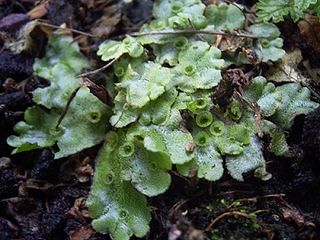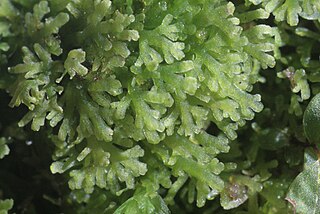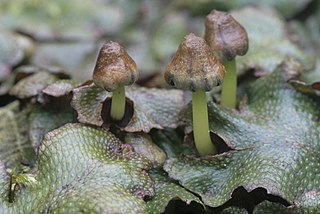
Mosses are small, non-vascular flowerless plants in the taxonomic division Bryophytasensu stricto. Bryophyta may also refer to the parent group bryophytes, which comprise liverworts, mosses, and hornworts. Mosses typically form dense green clumps or mats, often in damp or shady locations. The individual plants are usually composed of simple leaves that are generally only one cell thick, attached to a stem that may be branched or unbranched and has only a limited role in conducting water and nutrients. Although some species have conducting tissues, these are generally poorly developed and structurally different from similar tissue found in vascular plants. Mosses do not have seeds and after fertilisation develop sporophytes with unbranched stalks topped with single capsules containing spores. They are typically 0.2–10 cm (0.1–3.9 in) tall, though some species are much larger. Dawsonia, the tallest moss in the world, can grow to 50 cm (20 in) in height. There are approximately 12,000 species.

Bryophytes are a group of land plants, sometimes treated as a taxonomic division, that contains three groups of non-vascular land plants (embryophytes): the liverworts, hornworts and mosses. In the strict sense, Bryophyta consists of the mosses only. Bryophytes are characteristically limited in size and prefer moist habitats although they can survive in drier environments. The bryophytes consist of about 20,000 plant species. Bryophytes produce enclosed reproductive structures, but they do not produce flowers or seeds. They reproduce sexually by spores and asexually by fragmentation or the production of gemmae. Though bryophytes were considered a paraphyletic group in recent years, almost all of the most recent phylogenetic evidence supports the monophyly of this group, as originally classified by Wilhelm Schimper in 1879. The term bryophyte comes from Ancient Greek βρύον (brúon) 'tree moss, liverwort', and φυτόν (phutón) 'plant'.

The Marchantiophyta are a division of non-vascular land plants commonly referred to as hepatics or liverworts. Like mosses and hornworts, they have a gametophyte-dominant life cycle, in which cells of the plant carry only a single set of genetic information.

Hornworts are a group of non-vascular Embryophytes constituting the division Anthocerotophyta. The common name refers to the elongated horn-like structure, which is the sporophyte. As in mosses and liverworts, hornworts have a gametophyte-dominant life cycle, in which cells of the plant carry only a single set of genetic information; the flattened, green plant body of a hornwort is the gametophyte stage of the plant.

Marchantiales is an order of thallose liverworts that includes species like Marchantia polymorpha, a widespread plant often found beside rivers, and Lunularia cruciata, a common and often troublesome weed in moist, temperate gardens and greenhouses.

Marchantia is a genus of liverworts in the family Marchantiaceae and the order Marchantiales.

Metzgeriales is an order of liverworts. The group is sometimes called the simple thalloid liverworts: "thalloid" because the members lack structures resembling stems or leaves, and "simple" because their tissues are thin and relatively undifferentiated. All species in the order have a small gametophyte stage and a smaller, relatively short-lived, spore-bearing stage. Although these plants are almost entirely restricted to regions with high humidity or readily available moisture, the group as a whole is widely distributed, and occurs on every continent except Antarctica.

Riccia is a genus of liverworts in the order Marchantiales.

Conocephalum is a genus of complex thalloid liverworts in the order Marchantiales and is the only extant genus in the family Conocephalaceae. Some species of Conocephalum are assigned to the Conocephalum conicum complex, which includes several cryptic species. Conocephalum species are large liverworts with distinct patterns on the upper thallus, giving the appearance of snakeskin. The species Conocephalum conicum is named for its cone-shaped reproductive structures, called archegoniophores. Common names include snakeskin liverwort, great scented liverwort and cat-tongue liverwort.
Plant reproduction is the production of new offspring in plants, which can be accomplished by sexual or asexual reproduction. Sexual reproduction produces offspring by the fusion of gametes, resulting in offspring genetically different from either parent. Asexual reproduction produces new individuals without the fusion of gametes, resulting in clonal plants that are genetically identical to the parent plant and each other, unless mutations occur.

Cavicularia densa is the only species in the liverwort genus Cavicularia. The species was first described in 1897 by Franz Stephani, and is endemic to Japan, where it grows on fine moist soil.

Marchantia polymorpha is a species of large thalloid liverwort in the class Marchantiopsida. M. polymorpha is highly variable in appearance and contains several subspecies. This species is dioicous, having separate male and female plants. M. polymorpha has a wide distribution and is found worldwide. Common names include common liverwort or umbrella liverwort.

Aneura mirabilis is a parasitic species of liverworts in the family Aneuraceae. It was first described in 1933, as Cryptothallus mirabilis. Plants of this species are white as a result of lacking chlorophyll, and their plastids do not differentiate into chloroplasts.

Pellia epiphylla is a species of thallose liverwort. It occurs in North America, Europe, North Africa and parts of Asia. It grows in patches in damp, sheltered places on neutral or acidic substrates. It is common on the banks of rivers, streams and ditches and also grows in wet woodland, marshes and on wet rocks.

Sphaerocarpos texanus, the Texas balloonwort, is a species of liverwort in the Sphaerocarpaceae family, found in the Americas, northern Africa and Europe.

Tetraphis pellucida, the pellucid four-tooth moss, is one of two species of moss in the acrocarpous genus Tetraphis. Its name refers to its four large peristome teeth found on the sporophyte capsule.

Metzgeria furcata, the forked veilwort, is a frequent liverwort growing on the bark of a wide range of tree and shrub species and occasionally on rocks. It is a slim, translucent thallose liverwort that forms yellow-green mats of branches about 1mm wide.
Petalophyllum, or petalwort, is a genus of liverworts in the order Fossombroniales.

Asterella californica is a complex thallic liverwort in the phylum Marchantiophyta. A. californica often grows as colonies of flat rosettes of light green, rigid thalli, with undersides dark wine-red to nearly black. The receptacles are rounded, with four lobes each bearing a single sporangium sheathed by a white tattered skirt. A. californica is dioecious with separate male plants often intermingled with female plants. This species is found throughout California. See Distribution information below. Asterella californica is the commonest species of the three species of Asterella occurring in California; the other two species are A. bolanderi and A. palmeri.

Monoclea forsteri is one of the two species in the thallose liverwort family Monocleaceae. It is dioicous with the capsule dehiscing with a single longitudinal slit. Endemic and widely distributed throughout New Zealand, it is also the country's largest thalloid liverwort. Hooker described the species in 1820. The holotype is in the British Museum.



















